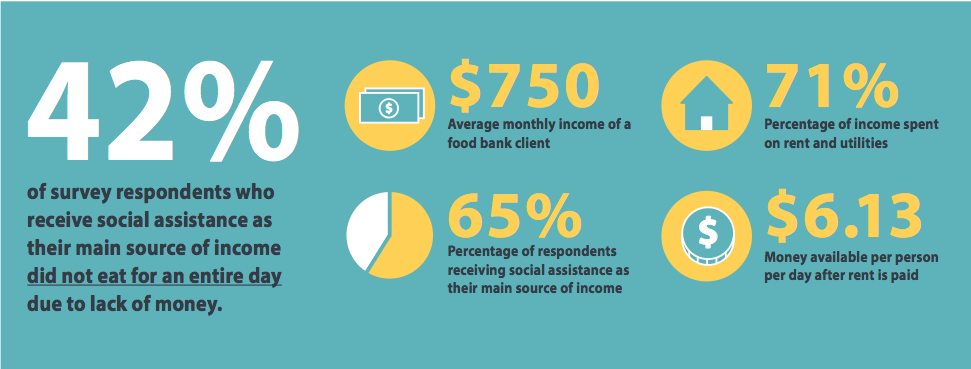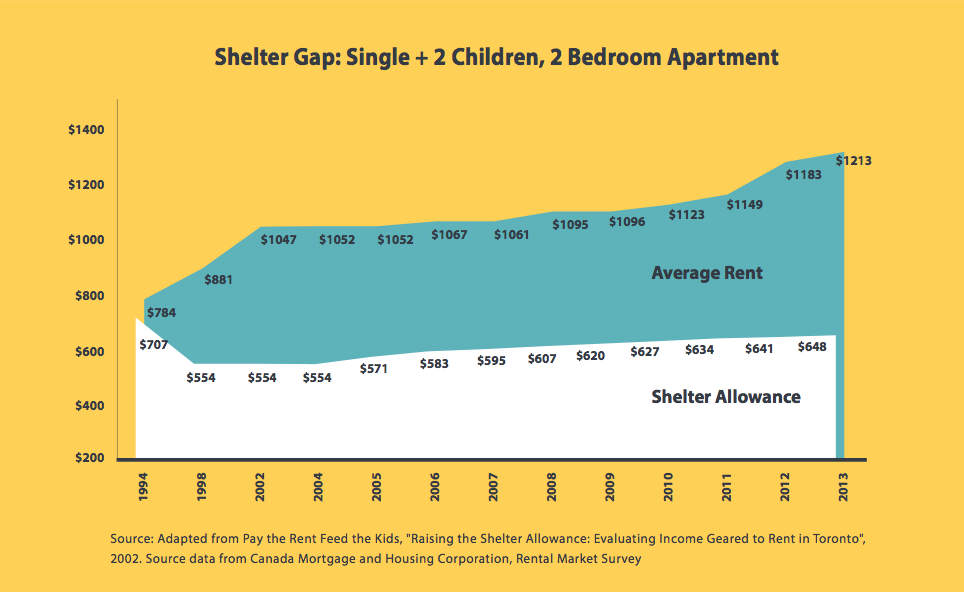It’s true that the challenges Canadians face with food insecurity are different from the challenges felt by countries in the global south. However, the call to reduce hunger resonates. On this World Food Day, let’s take a look at how housing affordability and the housing market are related to food access. The below infographic, published by the Daily Bread Food Bank as part of their 2014 Who’s Hungry report, illustrates the gap that exists between social assistance and the costs of food and shelter in the Greater Toronto Area.

Problems with food access are largely caused by rising housing costs in the GTA. One survey respondent recognized that “(the focus should be on) affordable housing because almost all our money goes to putting a roof over our heads.” The graph below shows how the divide between the cost of rent and shelter allowances has grown over the last two decades. Shelter allowances for single parents with two children have actually shown a net decrease; meanwhile the cost of rent has practically doubled. Rising housing costs mean that individuals are often only one accident or unexpected expense away from becoming homeless.

The average monthly income of a Daily Bread Food Bank client was reported to be $750 per month. This number “falls far below any standard of income or poverty measure”. After paying for rent, an individual has an average of $6.13 remaining for additional expenses. That’s $6.13 to cover three meals a day, transportation, necessities and any unexpected expenses. It’s no wonder over 40% of survey respondents receiving social assistance stated that there were times when they didn’t eat for an entire day. People in the GTA don’t go hungry because there is no food available. Their hunger is caused by a lack of funds to purchase food. Services provided by food banks, employment services and shelters are absolutely essential in lessening the burden on families and individuals.
As affordable housing becomes increasingly scarce, more funds need to be allocated to subsidize the cost of renting to bridge the above gap. Alternatively, governments can take a systems-based approach towards the issue and get involved in coupling a Housing First policy with constructing affordable housing units. Opting for the latter shows a long-term commitment to providing affordable housing, and can prove to be cost-efficient in the long run. The Calgary Homeless Foundation has taken this approach in the past, building 3,000 housing units over the course of a three-year project to respond to rising rental costs.
This trend of rising housing costs and the growing gap that exists between access to affordable housing and shelter allowances is not unique to the GTA. Similar trends can be observed in the US and other urban centres across Canada. It’s no wonder that food bank use has shown an overall increase over the past decade across the country. It’s unrealistic to attempt solving problems associated with food access in Canada without first talking about the need for more affordable housing. While we would like to think of Canada as being a country with a strong social safety net in place, these infographics illustrate that current efforts and funding for existing programs fall short of providing struggling individuals and families with their basic needs.

